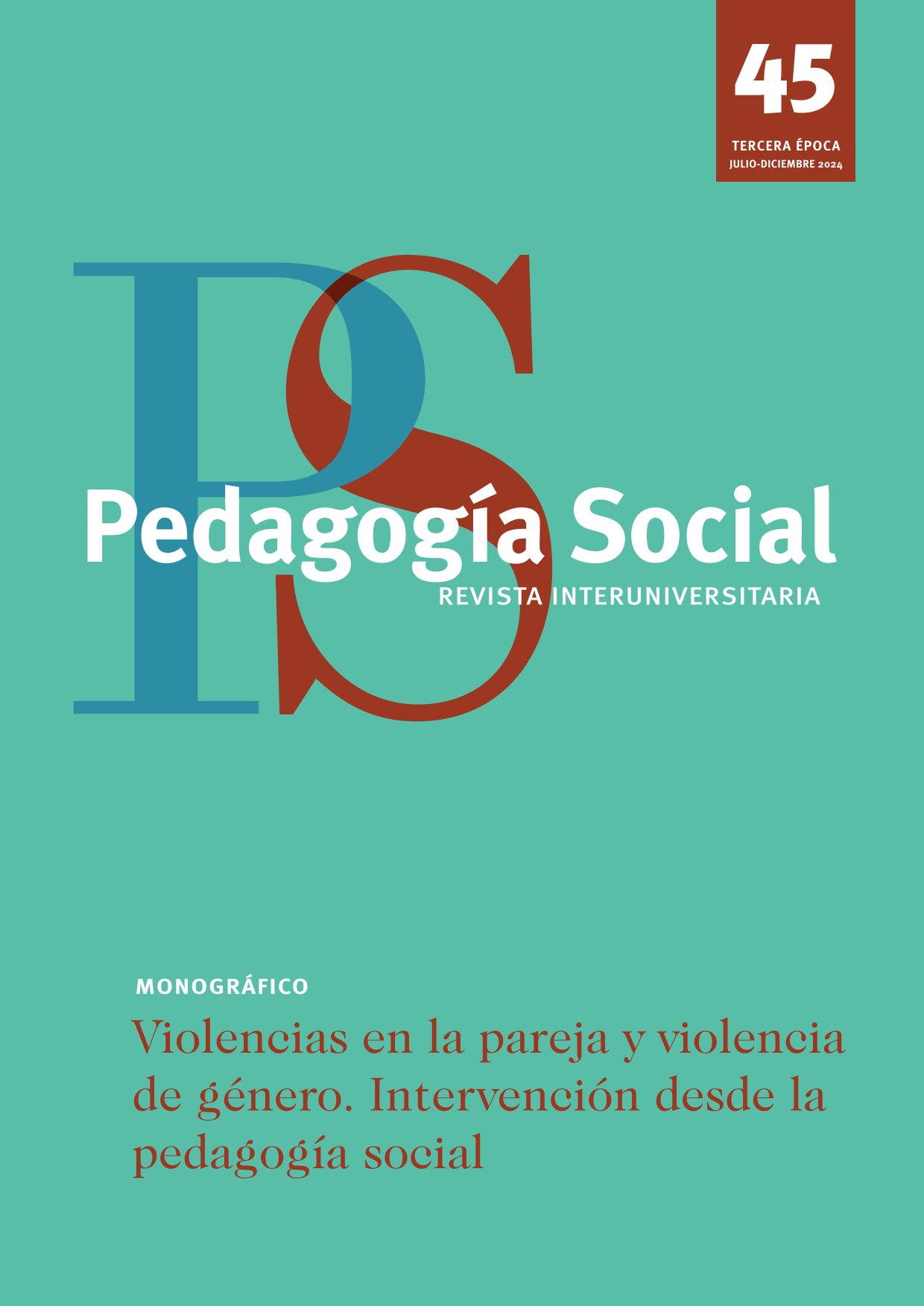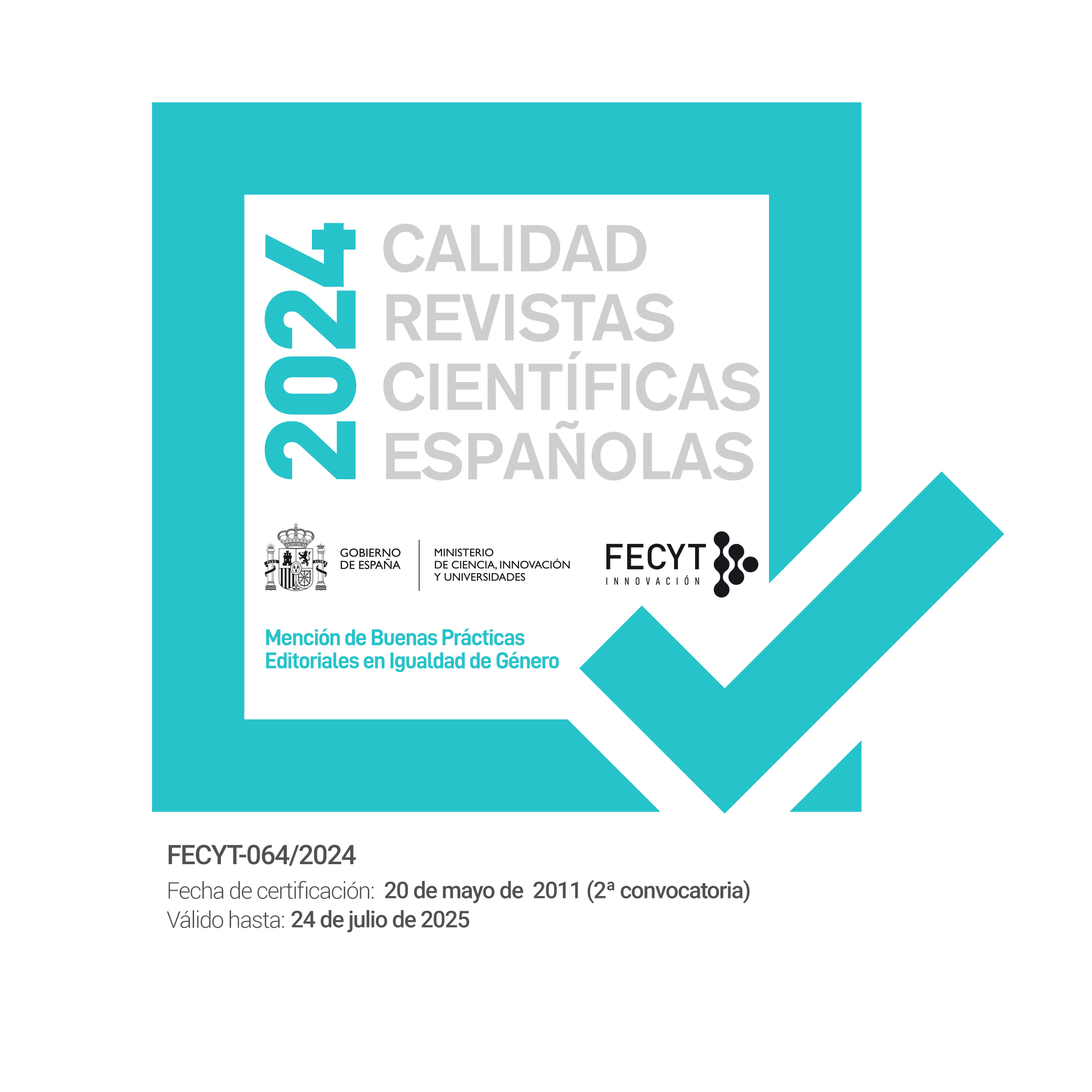Sextorsión: una estrategia de violencia sexual online en el estudiantado universitario
DOI:
https://doi.org/10.7179/PSRI_2024.45.02Palabras clave:
Sextorsión, violencia sexual, pareja, pedagogía feminista, sextingResumen
La violencia sexual ha encontrado en los medios tecnológicos y los espacios virtuales un contexto más en el que perpetrarse. Las estrategias de control, manipulación o chantaje sexual despliegan sus tentáculos entre las grietas de la red de redes, como una manifestación más de la violencia de género más perversa. Una de sus formas de expresión son las dinámicas de sextorsión que articulan violencias, tanto durante las relaciones afectivosexuales, como una vez que éstas han finalizado. El objetivo de esta investigación se centraba en analizar los comportamientos de sexting y las dinámicas de sextorsión vivenciadas por las/os universitarias/os; evaluando, paralelamente, la relación entre la victimización por sextorsión y los comportamientos y las motivaciones hacia el sexting relacionadas con la pareja afectivo-sexual. La muestra quedó formada por 3.293 (68.3 % chicas) estudiantes de la Universidad de Santiago de Compostela con un rango etario entre 18 y 56 años (M = 18.83; DT = 2.28). Los resultados identificaron que las conductas de sexting están normalizadas entre las/os jóvenes, especialmente entre las/os que indican mantener una relación de pareja. Respecto a la sextorsión, las cifras apuntaban que en torno a 3 de cada 100 estudiantes han sido víctimas de sextorsión por parte de su pareja afectiva y algo más de 2 de cada 100 ha sufrido venganza porno por parte de su expareja. Estas estrategias de violencia sexual online afectan en mayor medida a las chicas y a las personas de género no binario. No obstante, son las/os estudiantes que admiten mantener una relación sentimental las/os que son menos víctimas de sextorsión en todas sus formas de expresión. Los análisis de diferencias de medias y las correlaciones confirman las sinergias entre sextorsión, sexting y sexting motivado por la pareja afectiva.
Descargas
Citas
Alonso-Ruido, P., y Regueiro, B. (2022). El fenómeno del sexting: hacia un marco de intervención desde una pedagogía feminista. En T. Aránguez y O. Olariu (Eds.). Algoritmos, teletrabajo y otros grandes temas del feminismo digital (pp. 511-523). Dykinson.
Alonso-Ruido, P., Rodríguez, Y., Lameiras, M., y Román, R. (2017). Las motivaciones hacia el Sexting de los y las dolescentes gallegos/as. Revista de Estudios e Investigación en Psicología y Educación, 63, 13. https://doi.org/10.17979/reipe.2017.0.13.2280
Alonso-Ruido, P., Rodríguez, Y., Lameiras, M., y Martínez, R. (2018). El Sexting a través del discurso de adolescentes españoles. Saúde e Sociedade, 27, 398-409. https://doi.org/10.1590/S0104-12902018171835
Ballarín, P. (2015). Los códigos de género en la universidad. Revista Iberoamericana de Educación, 68, 19-38. https://doi.org/10.35362/rie680168
Barroso, R., Marinho, A. R., Figueiredo, P., Ramião, E., y Silva, A. S. (2023). Consensual and non-consensual sexting behaviors in adolescence: a systematic review. Adolescent Research Review, 8(1), 1-20. https://doi.org/10.1007/s40894-022-00199-0
Barroso, R., Pechorro, P., Ramião, E., Figueiredo, P., Manita, C., Gonçalves, R. A., y Nobre, P. (2020). Are Juveniles who have committed sexual offenses the same everywhere? Psychometric properties of the Juvenile Sex Offender Assessment Protocol–II in a Portuguese youth sample. Sexual Abuse, 32(7), 806-825. https://doi.org/10.1177/1079063219858070
Bjarnegård, E., Calvo, D., Eldén, Å., y Lundgren, S. (2022). Sextortion: corruption shaped by gender norms. En I. Kubbe y O. Merkle (Eds)., Norms, Gender and Corruption (pp. 252-267). Edward Elgar Publishing. https://doi.org/10.4337/9781802205831
Carrasco-Rueda, A. B., González, G., y Martínez, N. (2023). Revisión sistemática sobre la socialización de género en la etapa de educación infantil. Pedagogía Social, 43, 192-204. https://doi.org/10.7179/PSRI_2023.43.13
Cornelius, T. L., Bell, K. M., Kistler, T., y Drouin, M. (2020). Consensual sexting among college students: the interplay of coercion and intimate partner aggression in perceived consequences of sexting. International Journal of Environmental Research and Public Health, 17(19), 7141. https://doi.org/10.3390/ijerph17197141
Drouin, M., Ross, J., y Tobin, E. (2015). Sexting: A new, digital vehicle for intimate partner aggression? Computers in Human Behavior, 50, 197-204. https://doi.org/10.1016/j.chb.2015.04.001
Estévez, I., Seijo, A. S., y Sanmamed, M. G. (2023). Concepciones en torno al desarrollo profesional del docente universitario. En P. Muñoz, C. Sarceda, E. J. Fuentes y E. Barreira (Eds.), La formación y la innovación educativa: ejes para la transformación social (pp. 165-181). Dykinson.
García-Rojas, A. D., Calderón, N., Conde, S., y Civila, S. (2023). Aceptación y tolerancia del sexismo entre el alumnado de Ciencias de la Educación, Psicología y Ciencias del Deporte. Revista Complutense de Educación, 34(2), 415-426. https://dx.doi.org/10.5209/rced.79371
Greer, K. M., Cary, K. M., Maas, M. K., Drouin, M., y Cornelius, T. L. (2022). Differences between gender and relationship status in motivations and consequences of consensual sexting among emerging adults. Sexuality y Culture, 26(4), 1432-1451. https://doi.org/10.1007/s12119-022-09952-y
Haradhan, M. (2022). An Overview on the Feminism and Its Categories. Research and Advances in Education, 1, 11-26. https://doi.org/10.56397/RAE.2022.09.02
Harris, B. (2018). Spacelessness, spatiality and intimate partner violence: Technology-facilitated abuse, stalking and justice administration. En Fitz-Gibbon,K., Walklate, S., McCulloch, J., y Maher, J. M. (Eds.), Intimate partner violence, risk and security (pp. 52-70). Routledge.
Henry, N., Flynn, A., y Powell, A. (2020). Technology-facilitated domestic and sexual violence: A review. Violence Against Women, 26(15-16), 1828-1854. https://doi.org/10.1177/1077801219875821
Hong, S., Lu, N., Wu, D., Jimenez, D. E., y Milanaik, R. L. (2020). Digital sextortion: Internet predators and pediatric interventions. Current Opinion in Pediatrics, 32(1), 192-197. https://doi.org/10.1097/MOP.0000000000000854
Hutton, A. (2016). Sexual violence against transgender college students. En M. Paludi, (Ed.), Campus action against sexual assault: Needs, policies, procedures, and training programs (pp. 140-145). Praeger Publishers.
Jeffrey, N. K., Senn, C. Y., Krieger, M. A., y Forrest, A. (2023). The scope, nature, and impact of sexual violence among students from a Canadian university: A random sample study. Canadian Journal of Behavioural Science, 55(2), 100-112. https://doi.org/10.1037/cbs0000329
Kalish, R. (2023). Sexting in a post-feminist society: Balancing agentic empowerment and the sexual double standard. Women’s Studies International Forum, 98, 102726. https://doi.org/10.1016/j.wsif.2023.102726
Lelaurain, S., Fonte, D., Giger, J. C., Guignard, S., y Monaco, G. (2021). Legitimizing intimate partner violence: The role of romantic love and the mediating effect of patriarchal ideologies. Journal of Interpersonal Violence, 36(13-14), 6351-6368. https://doi.org/10.1177/0886260518818427
León, C. M., y Aizpurúa, E. (2020). ¿Persisten las actitudes sexistas en los estudiantes universitarios? Un análisis de su prevalencia, predictores y diferencias de género. Educación XX1, 23(1), 275-296. https://doi.org/10.5944/educXX1.23629
López-Neira, I., Patel, T., Parkin, S., Danezis, G., y Tanczer, L. (2019). ‘Internet of Things’: How abuse is getting smarter. Safe – The Domestic. Abuse Quarterly, 63, 22-26. http://dx.doi.org/10.2139/ssrn.3350615
Lundgren, S., Eldén, Å., Calvo, D., y Bjarnegård, E. (2023). Sextortion: linking sexual violence and corruption in a Nordic context. En M. Lundqvist, A. Simonsson, y K. Widegren (Eds.), Re-Imagining Sexual Harassment (pp. 129-152). Bristol University Press. https://doi.org/10.51952/9781447366546.ch010
Maddocks, S. (2022). Feminism, activism and non-consensual pornography: Analyzing efforts to end “revenge porn” in the United States. Feminist Media Studies, 22(7), 1641-1656. https://doi.org/10.1080/14680777.2021.1913434
Martínez-Bacaicoa, J., Real, N., Mateos, E., y Gámez, M. (2024). The role of gender and sexism in the moral disengagement mechanisms of technology-facilitated sexual violence. Computers in Human Behavior, 152, 108060. https://doi.org/10.1016/j.chb.2023.108060
Monsalve, L., y García, E. (2021). Prevalencia del sexting en adultos jóvenes universitarios: motivación y percepción del riesgo. Psychology, Society y Education, 13(1), 99-114. https://doi.org/10.25115/psye.v1i1.3482
Morelli, M., Bianchi, D., Baiocco, R., Pezzuti, L., y Chirumbolo, A. (2016). Sexting, psychological distress and dating violence among adolescents and young adults. Psicothema, 28(2), 137-142. https://doi.org/10.7334/psicothema2015.193
Nelson, A., Allen, J., Cho, H., Yun, S. H., Choi, Y. J., y Choi, G. Y. (2023). Intimate partner violence and openness to online counseling among college students. Journal of Family Violence, 38(4), 611-621. https://doi.org/10.1007/s10896-022-00396-4
The National Campaign to Prevent Teen and Unplanned Pregnancy (NCPTUP) (2008). Sex and Tech: results from a survey of teens and young adults. https://lc.cx/xqFydV
O’Malley, R. L. (2023). Short-term and long-term impacts of financial sextortion on victim’s mental well-being. Journal of Interpersonal Violence, 38(13-14), 8563-8592. https://doi.org/10.1177/08862605231156416
Pastor-Moreno, G., Ruiz, I., Sordo, L., y Henares, J. (2022). Frequency, types, and manifestations of partner sexual violence, non-partner sexual violence and sexual harassment: A population study in Spain. International Journal of Environmental Research and Public Health, 19(13), 8108. https://doi.org/10.3390/ijerph19138108
Patel, U., y Roesch, R. (2022). The prevalence of technology-facilitated sexual violence: A meta-analysis and systematic review. Trauma, Violence, y Abuse, 23(2), 428-443. https://doi.org/10.1177/1524838020958057
Pavón-Benítez, L., Romo, N., y Tarancon, P. (2021). “In my village everything is known”: sexting and revenge porn in young people from rural Spain. Feminist Media Studies, 22(8), 2020-2036. https://doi.org/10.1080/14680777.2021.1935290
Powell, A., y Henry, N. (2019). Technology-facilitated sexual violence victimization: Results from an online survey of Australian adults. Journal of Interpersonal Violence, 34(17), 3637-3665. https://doi.org/10.1177/0886260516672055
Rodríguez, Y., Alonso-Ruido, P., González, A., Lameiras, M., y Faílde, J. M. (2021). Validación de la escala de comportamientos de sexting en adolescentes: prevalencia y consecuencias asociadas. Psicología Educativa, 27(2) 177-185. https://doi.org/10.5093/psed2021a9
Sedano, S., Lorente, J., Ballester, L., y Aznar, B. (2024). Acceso, consumo y consecuencias del consumo de pornografía entre adolescentes: nuevos retos para la educación afectivo-sexual. Pedagogía Social, 44, 161-175. https://doi.org/10.7179/PSRI_2024.44.09
Snaychuk, L. A., y O’Neill, M. L. (2020). Technology-facilitated sexual violence: Prevalence, risk, and resiliency in undergraduate students. Journal of Aggression, Maltreatment y Trauma, 29(8), 984-999. https://doi.org/10.1080/10926771.2019.1710636
Soriano, A. (2011). La violencia en relaciones de pareja en estudiantes universitarios: propuestas educativas. Pedagogía Social, 18, 87-97. https://doi.org/10.7179/psri_2011.18.07
Van-Ouytsel, J., Van, E., Walrave, M., Ponnet, K., y Peeters, E. (2017). Sexting: adolescents’ perceptions of the applications used for, motives for, and consequences of sexting. Journal of Youth Studies, 20(4), 446-470. https://doi.org/10.1080/13676261.2016.1241865
Varela-Portela, C., Alonso, P., y Regueiro, B. (2024). Los planes de estudio en Educación Superior: ¿Es el género una prioridad?. Revista Fuentes, 26(1), 95-108. https://doi.org/10.12795/revistafuentes.2024.24014
Walker, K., Sleath, E., Hatcher, R. M., Hine, B., y Crookes, R. L. (2021). Nonconsensual Sharing of Private Sexually Explicit Media Among University Students. Journal of Interpersonal Violence, 36(17-18), NP9078-NP9108. https://doi.org/10.1177/0886260519853414
Weisskirch, R., y Delevi, R. (2011). ‘‘Sexting’’ and adult romantic attachment. Computers in Human Behavior, 27(5), 1697-1701. https://doi.org/10.1016/j.chb.2011.02.008
Wolak, J., Finkelhor, D., Walsh, W., y Treitman, L. (2018). Sextortion of minors: characteristics and dynamics. Journal of Adolescent Health, 62, 72-79. https://doi.org/10.1016/j.jadohealth.2017.08.014
Publicado
Cómo citar
Número
Sección
Licencia

Esta obra está bajo una licencia internacional Creative Commons Atribución-NoComercial-CompartirIgual 4.0.
Derechos de reproducción y archivo
La versión publicada de los artículos podrá ser autoarchivada por sus autores en repositorios institucionales y temáticos de acceso abierto. No obstante la reutilización total o parcial de los mismos en nuevos trabajos o publicaciones deberá ser autorizada por Pedagogía Social. Revista Interuniversitaria.
Los trabajos publicados deberán ser citados incluyendo el título de la Revista, Pedagogía Social. Revista Interuniversitaria, nº, páginas y año de publicación.
Responsabilidades éticas
Pedagogía Social. Revista Interuniversitaria no acepta material publicado anteriormente en otros documentos. Los/as autores/as son responsables de obtener los permisos oportunos para reproducir parcialmente material de otras publicaciones y citar correctamente su procedencia. Estos permisos deben solicitarse tanto al autor/a como a la editorial que ha publicado dicho material.
Es obligación de Pedagogía Social. Revista Interuniversitaria detectar y denunciar prácticas fraudulentas.
En la lista de autores/as firmantes deben figurar únicamente aquellas personas que han contribuido intelectualmente al desarrollo del trabajo.
La revista espera que los/as autores/as declaren cualquier asociación comercial que pueda suponer un conflicto de intereses en conexión con el artículo remitido.
Los autores deben mencionar en el manuscrito, preferentemente en el apartado del método, que los procedimientos utilizados en los muestreos y controles han sido realizados tras la obtención de consentimiento informado.
La revista no utilizará ninguno de los trabajos recibidos con otro fin que no sea el de los objetivos descritos en estas normas.
Aviso de derechos de autor/a
© Pedagogía Social. Revista Interuniversitaria. Los originales publicados en las ediciones impresa y electrónica de esta Revista son propiedad del Pedagogía Social. Revista Interuniversitaria, siendo necesario citar la procedencia en cualquier reproducción parcial o total.
Salvo indicación contraria, todos los contenidos de la edición electrónica se distribuyen bajo una licencia de uso y distribución “Creative Commons Reconocimiento-No Comercial 3.0 España” (CC-by-nc). Puede consultar desde aquí la versión informativa y el texto legal de la licencia. Esta circunstancia ha de hacerse constar expresamente de esta forma cuando sea necesario.






